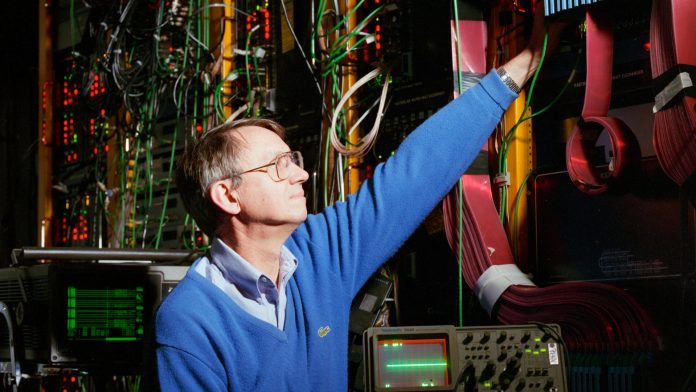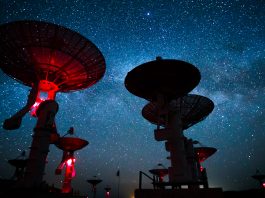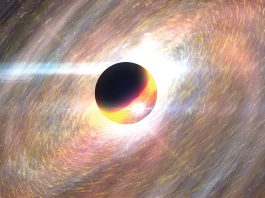Duke University’s Professor Emeritus Alfred Goshaw describes his journey as a physicist in the field of elementary particle physics, from graduate student to CERN’s ATLAS experiment, extolling the virtues of science to go beyond politics to an environment of co-operation across nationalities and cultures.
This article contains stories about research in the field of elementary particle physics. It is not for experts in the field, but directed to others who are curious about how the field has evolved from the dawn of the Standard Model in the 1960s to activities today that require the use of mega particle detectors. The perspective is from the journey I began as a graduate student at the University of Wisconsin and continued through involvement with the CDF and ATLAS collaborations. One message I want to convey is that these large experiments, and the hosting laboratories Fermilab and CERN, in addition to being essential for the advancement of our understanding of elementary particles, are also wonderful models for co-operation between people independent of their culture or nationality.
There was a three-hour wait in the queue. The occasion was not the premier of another Star Wars movie, but instead an open house at the international laboratory CERN in Geneva Switzerland. It was September 2019, and people were lined up for the opportunity to visit the mammoth ATLAS detector located in the Large Hadron Collider tunnel. I had volunteered as a tour guide and was stunned by the turnout. Even more surprising were the reactions of some of the visitors to seeing a particle detector the size of a three-story building. Their response inspired me to reflect on the evolution of experimental high energy physics from early research conducted by a few individuals to experiments requiring the co-operative effort of thousands of physicists, engineers, and technicians. It is a personal journey covering 60 years of research in this field.
The beginning
My physics adventures began as a graduate student at the University of Wisconsin-Madison in the early 1960s. My adviser, William Walker, suggested that I search for an excited state of the K meson, the lowest mass particle containing a strange quark.
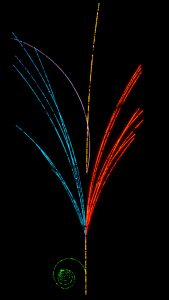
This was a big deal in those days, and I was thrilled to have the opportunity to discover a new particle! This so-called ‘kappa meson’ had properties (spin-parity = 0+) similar to the Higgs boson that entered later in my career.
In the 1960s, the detectors of choice were bubble chambers. My research utilised an 80-inch hydrogen-filled chamber located at Brookhaven National Laboratory. The data was collected at a glacial rate with bursts of K+ mesons fired every few seconds into the bubble chamber. The mesons collided with target protons, creating new particles whose trajectories were detected by a trail of bubbles in the hydrogen. The bubbles were illuminated by a flash of light, and the images recorded on film. The photographs were later projected onto scanning tables, where the bubble trails were painstakingly digitised by hand and the data recorded on punched cards. In the evenings, my job was to carry boxes of cards to the local IBM 704 computer where I ran programs that turned the digitisation of the bubbles into geometric spirals that allowed calculation of the particle’s momenta. The programs often ran for many hours, producing reams of paper output. One bonus of this time was romantic: I used these evenings as an opportunity to spend time with my future wife (it must have been the world’s most boring date).
In those days, as part of a research group of four people, I was able to touch everything in the experiment, starting with calibrating the K meson beam and studying of bubble chamber operation, then writing the data analysis programs from scratch, and finally preparing the physics plots (hand drafted with pen and ink, of course). I presented the final results of this search in a ten-minute talk at a physics conference in New York in 1965. Alas, my first research effort did not find a new particle in Nature. For more details, do a Google search for the ‘kappa meson’, where (amazingly) this experiment is still listed.
Fast forward through the next several decades when I spent time as a post doc at Princeton, then a research fellow at CERN, and finally joined Duke University as a professor in 1973. My research continued with the aid of many other bubble chambers, using experiments at laboratories such as Argonne National Laboratory in Chicago, Brookhaven National Laboratory in New York, the Stanford Linear Accelerator Center in California, and CERN, pursuing various efforts to validate the theory of the Standard Model (SM) through studies of strange and charm particles and exploring other predictions of the SM’s electroweak sector.
The SSC
In the early 1990s, as a sideline, I joined a group advocating my home state of North Carolina as the site of a proposed Superconducting Super Collider (SSC) that would provide proton-proton collisions at the colossal centre of mass energy of 40 TeV. Despite our efforts, Texas was chosen as the SSC’s site. I nevertheless continued involvement in the SSC project and planned to travel to Waxahachie, Texas in the fall of 1993 as a manager of one of the detector projects. This was abruptly cut short when federal funding for the SSC was terminated on 21 October, 1993, despite the fact that about one-quarter of the tunnel had been excavated. Not a great record for me: no kappa meson, and no SSC in North Carolina or Texas. The SSC project failed in part because of the inability to secure involvement and funding from other countries.
Fermilab
Disappointed, but undeterred, my group at Duke turned to an accelerator facility (the Tevatron) located at Fermilab in Batavia, Illinois. This provided proton-antiproton collisions at only 5% of the centre of mass energy of the ill-fated SSC, but still at the current energy frontier. The experiments at Fermilab were in hot pursuit of a particle called the ‘top quark’ that was expected from the SM’s pattern of elementary particles. My participation in this experiment began with the humble task of getting the timing electronics checked out and ready for installation in the data acquisition system. In this experiment, the trajectory of particles produced electric charge deposits that were directly recorded as digital signals and used to reconstruct particle trajectories at a blazing speed compared to the bubble chamber era. In April 1995, the CDF and the D0 collaborations together publicly announced the discovery of the top quark, having the staggering mass of a gold atom. This is still the record holder for the most massive elementary particle.
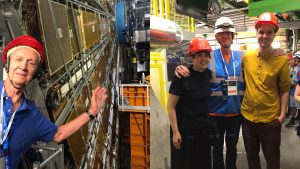
Cultural and intellectual diversity
My research at CDF continued after the discovery of the top quark, and during this time I worked my way up through the ranks as convener of physics groups. To my surprise, I was elected co-spokesperson of the experiment in 1997 and served in that role for six years. I had moved far beyond my four-person research project. The CDF experiment was a collaboration of six hundred scientists and revealed the challenges and tremendous advantages of working with a large group of scientists. The breadth of the group’s backgrounds fostered a diversity of approaches to scientific questions. The interaction with an international community of scientists was a fantastic experience, and I often referred to our experiment as ‘CDF University’, since within our community there was such a wonderful richness of cultural diversity and intellectual pursuits.
In 2005, I entered the final stage of my career by joining the ATLAS experiment at the CERN Large Hadron Collider (LHC), which is designed to provide proton-proton collisions at a centre of mass energy of 14 TeV. The CDF experiment prepared me well for this transition. Compared to my original research in the 1960s, everything was scaled upwards by a factor of about 1,000. The ATLAS collaboration now consisted of 3,000 physicists, and the energy scale of elementary particles being explored increased from about 1 GeV to 1 TeV. Finally, the rate for recording the products from particle collisions increased from the glacial scale of a few tenths of Hz using bubble chambers to kHz. And of course, like at CDF, the ATLAS detector components provide direct electronic digitisation of the particle trajectories. No more bubbles recorded on film; no army of scanners; and no more punch cards. The data acquired is processed with a world-wide collection of computers. During my tenure with the ATLAS experiment, the last missing piece of the SM was discovered in 2012. This particle, the Higgs boson, has a much more profound role in the SM than my humble kappa meson, but shares similar properties (spin-parity = 0+).
Research at CERN is a long journey from my graduate school days. Sort of like moving from a one room schoolhouse to a major university. The enormous advantage is the opportunity to work with colleagues with a broad range of scientific expertise and creative ideas. One of my favourite places is the cafeteria at CERN, where I can brush shoulders with colleagues from all over the world. As an example, the collaborators in my current research activities at ATLAS include physicists from the United States, China, Israel, and Russia. What might be a politically explosive mix, turns into a lovely example of co-operation across nationalities.
Back to 2019 and the three-hour queue for the ATLAS detector: one of my tour groups included a woman who had been looking forward to an opportunity to see the CERN laboratory for over ten years. As we emerged from the underground cavern containing the ATLAS detector, to my distress, I noted she was she crying – until she explained they were tears of joy. She was overwhelmed by the staggering size of the detector and moved by the diversity of scientific teams required to carry out the research. It was another reminder that beyond the scientific return, the CERN laboratory has a societal impact by providing an example of what humanity can achieve when politics falls away and instead there is co-operation across nationalities and cultures. An especially important lesson in these turbulent times.
Acknowledgements
To Bill, who sent me on a search for the kappa meson; to Jene, for helping me carry boxes of IBM cards; and to Mikaela, who cried after the tour of ATLAS.
Professor Alfred T Goshaw
Department of Physics
Duke University
+1 (919) 660 2584
goshaw@phy.duke.edu
Tweet @DukePhysics
https://phy.duke.edu
Please note, this article will also appear in the third edition of our new quarterly publication.

